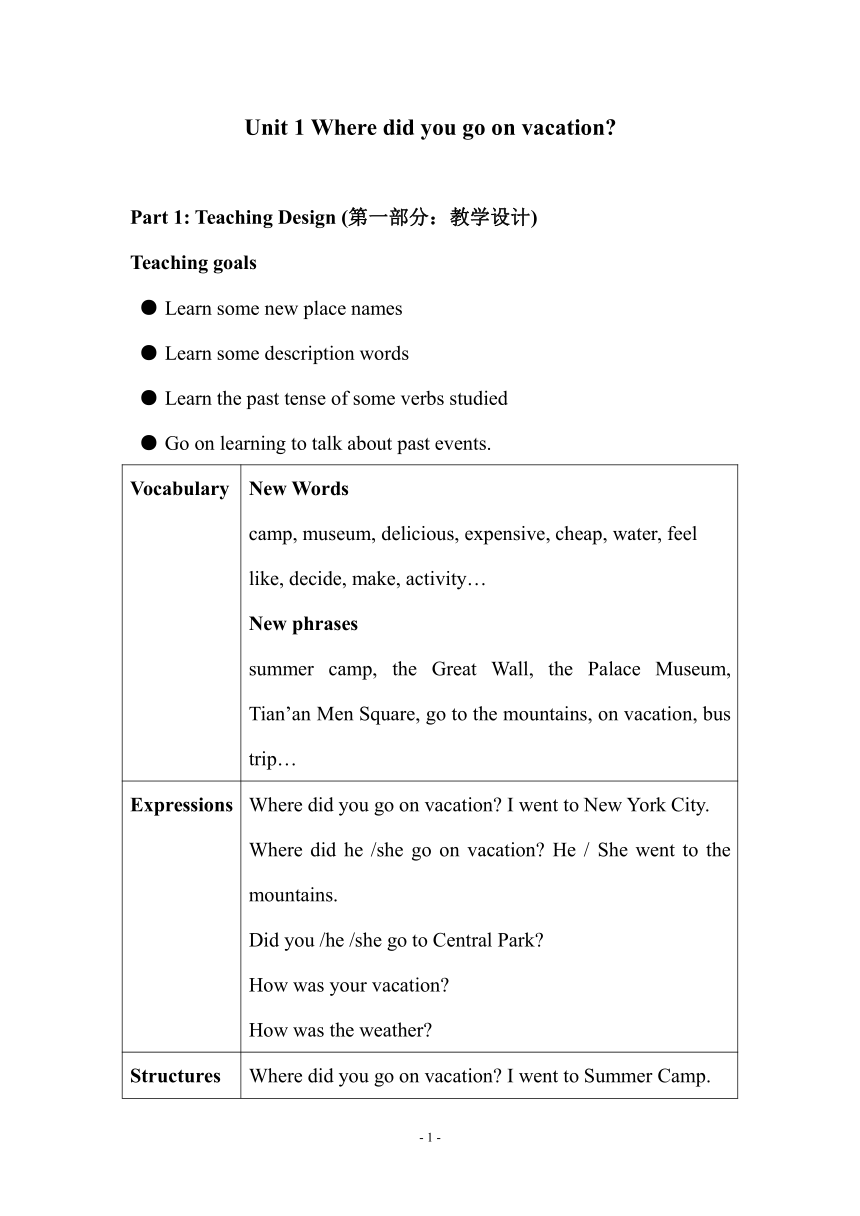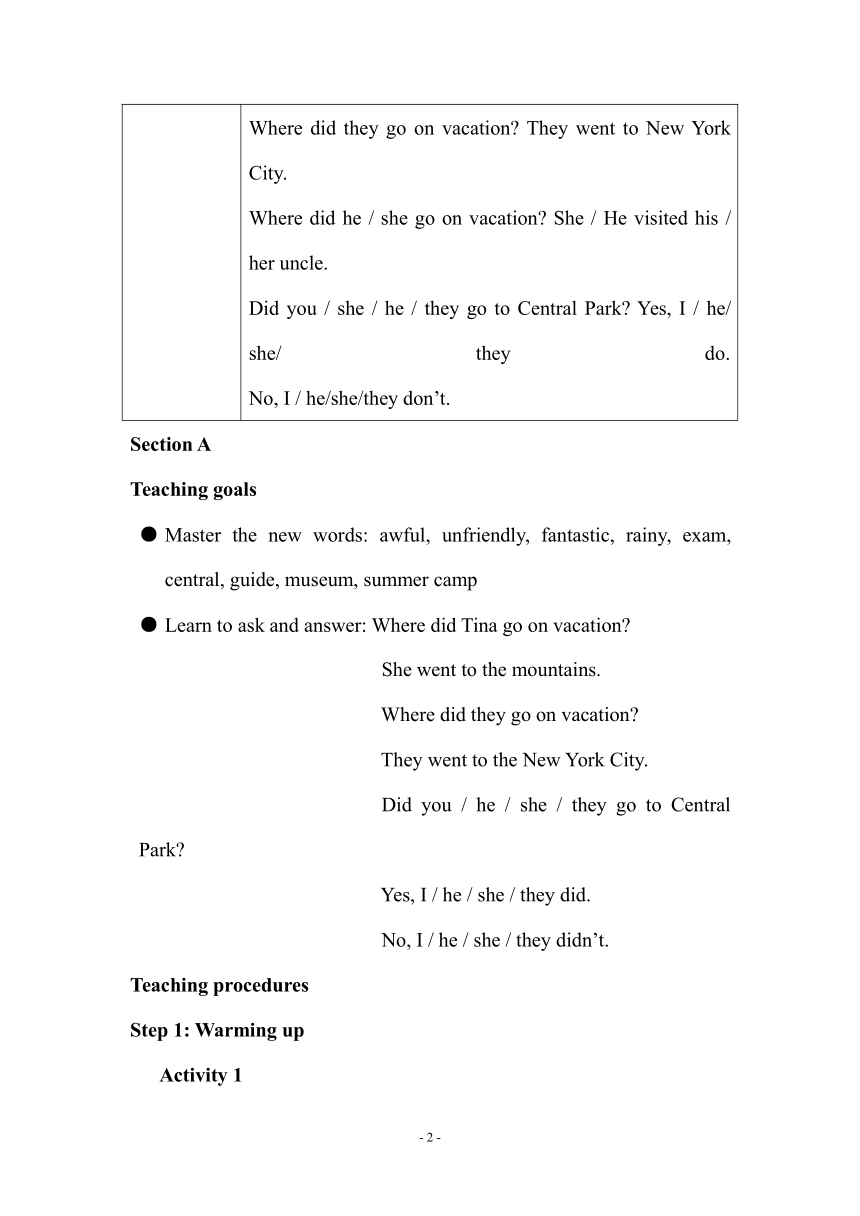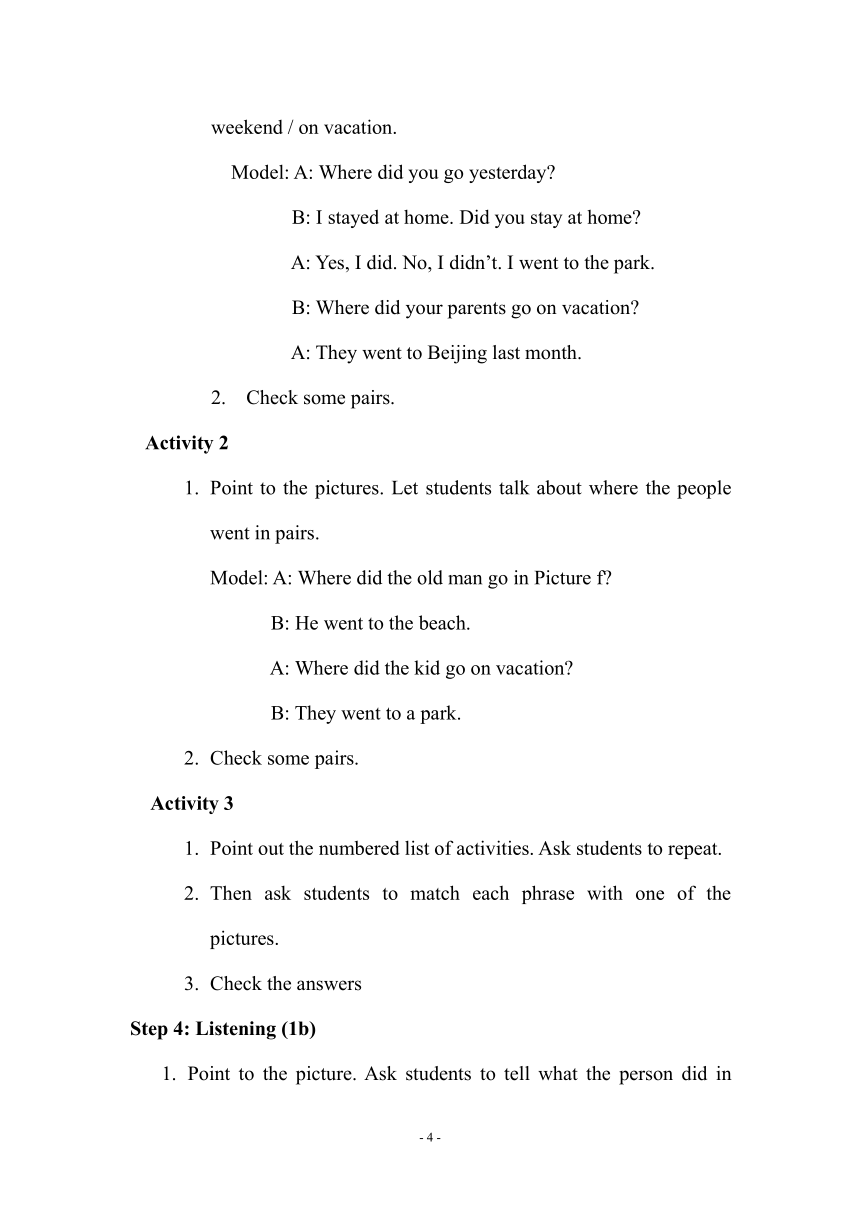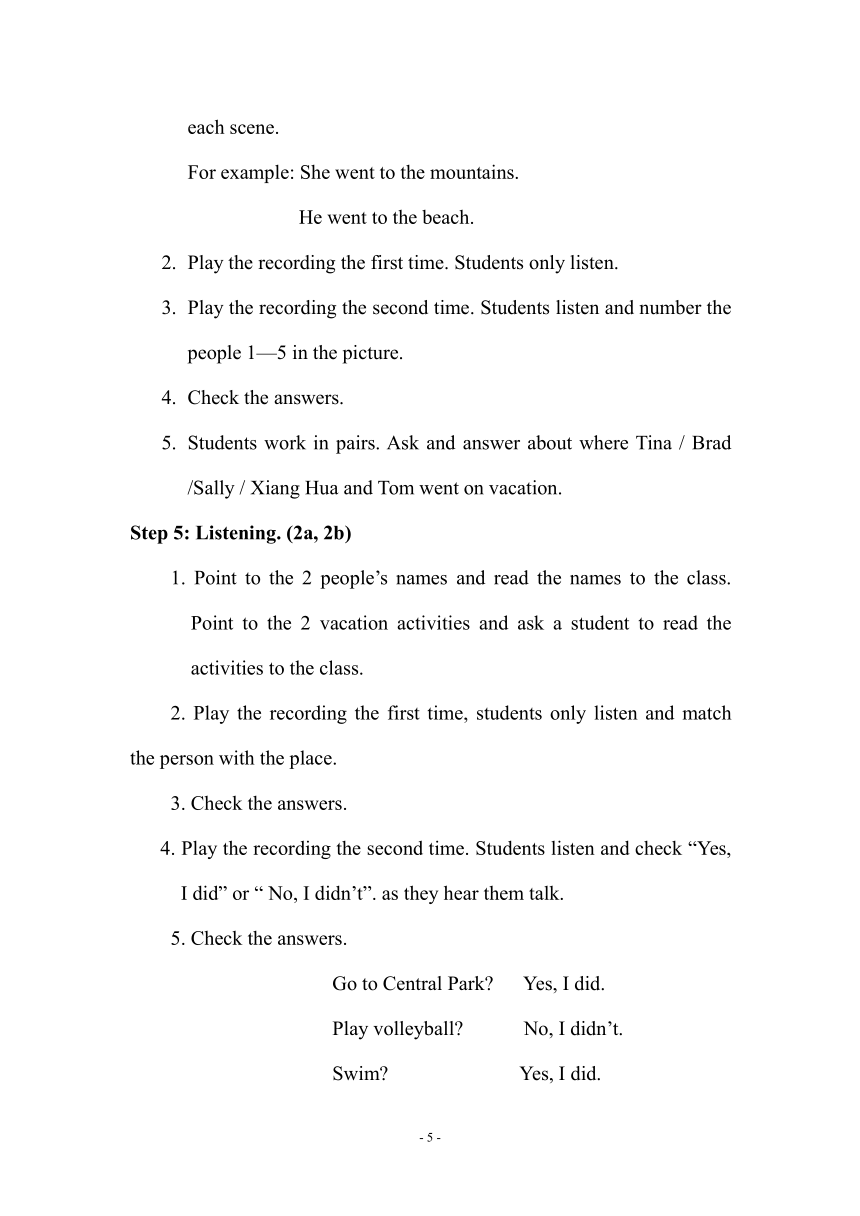人教版八年级上册Unit 1 Where did you go on vacation?Section B教案
文档属性
| 名称 | 人教版八年级上册Unit 1 Where did you go on vacation?Section B教案 |  | |
| 格式 | doc | ||
| 文件大小 | 60.0KB | ||
| 资源类型 | 教案 | ||
| 版本资源 | 人教新目标(Go for it)版 | ||
| 科目 | 英语 | ||
| 更新时间 | 2022-09-04 18:44:21 | ||
图片预览





文档简介
Unit 1 Where did you go on vacation
Part 1: Teaching Design (第一部分:教学设计)
Teaching goals
● Learn some new place names
● Learn some description words
● Learn the past tense of some verbs studied
● Go on learning to talk about past events.
Vocabulary New Wordscamp, museum, delicious, expensive, cheap, water, feellike, decide, make, activity…New phrasessummer camp, the Great Wall, the Palace Museum, Tian’an Men Square, go to the mountains, on vacation, bus trip…
Expressions Where did you go on vacation I went to New York City.Where did he /she go on vacation He / She went to the mountains.Did you /he /she go to Central Park How was your vacation How was the weather
Structures Where did you go on vacation I went to Summer Camp.Where did they go on vacation They went to New York City.Where did he / she go on vacation She / He visited his / her uncle.Did you / she / he / they go to Central Park Yes, I / he/ she/ they do. No, I / he/she/they don’t.
Section A
Teaching goals
● Master the new words: awful, unfriendly, fantastic, rainy, exam, central, guide, museum, summer camp
● Learn to ask and answer: Where did Tina go on vacation
She went to the mountains.
Where did they go on vacation
They went to the New York City.
Did you / he / she / they go to Central Park
Yes, I / he / she / they did.
No, I / he / she / they didn’t.
Teaching procedures
Step 1: Warming up
Activity 1
1. Teacher lists some verbs on the blackboard.
visit, go, stay, have, do, practice, am, are
2. Ask students to change the words into the past forms together.
visited, went, studied, had, did, practiced,
Read the past forms loud.
Activity 2
Go on asking what you / he / she/ did last weekend using the verbs they learned. Focus their attention on the form of verbs.
Step 2: Presenting
1. Let students say out the verbs learnt before and teacher can help them say as many as possible.
2. Ask students: Did you stay at home yesterday
Did you stay at school last weekend
Where did you go on vacation
Where did your parents go on vacation
3. Repeat the new language points.
Step 3: Practicing
Activity 1
1. Students work in pairs. Ask and answer about where their parents, friends and they themselves went yesterday / last weekend / on vacation.
Model: A: Where did you go yesterday
B: I stayed at home. Did you stay at home
A: Yes, I did. No, I didn’t. I went to the park.
B: Where did your parents go on vacation
A: They went to Beijing last month.
2. Check some pairs.
Activity 2
1. Point to the pictures. Let students talk about where the people went in pairs.
Model: A: Where did the old man go in Picture f
B: He went to the beach.
A: Where did the kid go on vacation
B: They went to a park.
2. Check some pairs.
Activity 3
1. Point out the numbered list of activities. Ask students to repeat.
2. Then ask students to match each phrase with one of the pictures.
3. Check the answers
Step 4: Listening (1b)
1. Point to the picture. Ask students to tell what the person did in each scene.
For example: She went to the mountains.
He went to the beach.
2. Play the recording the first time. Students only listen.
3. Play the recording the second time. Students listen and number the people 1—5 in the picture.
4. Check the answers.
5. Students work in pairs. Ask and answer about where Tina / Brad /Sally / Xiang Hua and Tom went on vacation.
Step 5: Listening. (2a, 2b)
1. Point to the 2 people’s names and read the names to the class. Point to the 2 vacation activities and ask a student to read the activities to the class.
2. Play the recording the first time, students only listen and match the person with the place.
3. Check the answers.
4. Play the recording the second time. Students listen and check “Yes, I did” or “ No, I didn’t”. as they hear them talk.
5. Check the answers.
Go to Central Park Yes, I did.
Play volleyball No, I didn’t.
Swim Yes, I did.
Go to the movies No, I didn’t.
Study for exams Yes, I did.
6. Students work in groups and talk about the activities in the chart and other activities.
Model: Reporter: Nancy, where did you go on vacation
Nancy: I went to New York City.
R: Really Did you go to Central Park
N: Yes, I did.
Ask Kevin and Julie in the same way.
6. Check some pairs.
Step 6: Practicing
Activity 1
1. Ask students to say out different kinds of weather learnt before.
rainy, snowy, sunny, windy, cloudy, hot, cold, warm, cool, humid
2. Ask students: What’s the weather like today
How was the weather yesterday
How was the weather last Sunday
How was your last Sunday
Activity 2
1. Point to the example. Read it to the class.
2. Ask students to work alone and fill in the blanks in the conversation, using “was” “were”
3. Check the answers.
4. Students practice the conversation in pairs and act out.
Activity 3
1. Point to each of the pictures and ask students to say what they see. Then read the words under each picture. Pronounce any new word and explain the meanings of them if necessary.
2. Students work in pairs and make their own conversations about the pictures.
Model: A: How was your vacation
B: It was fantastic.
A: Where did you go
B: I went to the mountains.
A: How were the mountains
B: They were beautiful.
A: How was the bus trip
B: It was relaxing.
Activity 4
Ask students to take out their photos of vacations and show their photos to the classmates and talk about their own vacations.
Model: I went to Xi’an on vacation last year.
It’s a very old city. The weather was sunny. My parents and I visited the Bell Tower. The people there were friendly --
Section B
Teaching goals
● Master the new words: water, cry, corner, feel, decide, make, classmate, discuss, report, activity
● Learn to use new sentences:
We had great fun playing in the water.
The shops were too crowded.
I didn’t really enjoy it.
I found a small boy crying in the corner.
That made me feel very happy.
We decided to play tennis.
Teaching procedures
Step 1: Making a revision
Ask students: What did you have for breakfast / lunch / supper yesterday
How was your breakfast / lunch/ supper yesterday
Where did you go on vacation
What did you do on vacation
Guide students to answer the questions in past tense and try to use the description words they learnt before.
Step 2: Practicing
Activity 1
1. Point to the words. Say each word and let students repeat it.
2. Describe the picture as a model for students:
This is a ring. It’s one hundred million dollars. It’s expensive.
3. Ask students to describe the other 5 pictures in the same way.
4. Ask students to match the words with the pictures.
5. Check the answers.
Activity 2
1. Point out the smiley face and frowny face. Say the smiley face is for good things. The frowny face is for bad things.
2. Call attention to the six words in 1a. ask students to write each word under smiley face or frowny face individually.
3. Check the answers: Smiley face: delicious, cheap, not crowded. Frowny face: awful, expensive, crowded
4. Students ask and answer about the 6 pictures in pairs.
Model: A: How is the ring
B: It’s expensive.
Step 3: Reading
1. Point to the 2 questions in 2a. ask a student to read them to the class. Draw students’ attention to listen to Vera talking about her vacation carefully.
2. Play the recording the first time. Students listen and write down the answers to the questions in the blanks in 2a. Check the answers.
3. Call students’ attention to the chart in 2b. Play the recording the second time. Students listen carefully and fill in the chart.
4. Check the answers.
5. Students listen again and repeat.
6. Students work in pairs. Sa is Vera’s friend. Sb is Vera. Talk about Vera’s vacation, using the information in the chart in 2b. Sa begins his questions with these words.
Where did...
What did ...
Did you ...
How was ...
How were ...
Step 4:
1. Call students’ attention to Bob’s diary and give students some questions. Let students read the diary alone and find out the answers to the questions given.
Question 1: How was the weather on July 15th / July 16th / July 17th
Question 2: Where did he go on July 15th / July 16th / July 17th
Question 3: What did he do on the 3 days
Question 4: How were his 3 days on the vacation
2. Check the answers.
3. Explain the instructions in 3a. Then ask students to read the article alone again to circle the good things about his vacation and underline the bad things.
4. Check the answers.
5. Call students’ attention to the new phrases in the diary.
have fun doing sth, be crowded, find sb doing sth, be lost, help sb do sth. Make sb do sth, walk back to, decide to do sth
Explain the phrases and give more examples to use them. Then let students make up their own sentences with the phrases above.
Step 5: Writing
1. Students work in pairs and talk about the places of interest.
2. Students take out a piece of paper and work alone to write a travel diary, imagining they are foreigners on vacation in Beijing. They can go like this:
Thursday, August 1st
Today I went to the Place Museum. It was cool. Then I ....
3. Ask some individual students to read their diary to class.
Self-check
Teaching goals
● Help students to review all the key vocabulary presented in this unit.
● Help students practice writing a survey using the past tense.
● Give students an opportunity to use the target language in conversation.
Teaching Procedures
Step 1: Learning words
1. Ask students to read the key words in Part 1 aloud and know the meaning of them.
2. Ask students to divide the words in 3 groups.
1) verbs: stayed at home, visited
2) nouns: vacation, summer camp, mountain, museum,
3) adjectives: delicious, awful, cheap, crowded,
3. Ask students to write five or more new words in their vocab-builder.
Step 2: Making a survey
1. Draw students’ attention to the form and explain the instructions above it.
2. Ask students to fill in the form with the information about their last vacation.
3. Ask students to work in groups of four and ask their classmates questions about their last vacation.
4. After students finished asking questions. Tell them to discuss in their groups about the best place for a vacation.
5. Ask several groups to tell the class which place they think is the best vacation destination.
6.
- 1 -
Part 1: Teaching Design (第一部分:教学设计)
Teaching goals
● Learn some new place names
● Learn some description words
● Learn the past tense of some verbs studied
● Go on learning to talk about past events.
Vocabulary New Wordscamp, museum, delicious, expensive, cheap, water, feellike, decide, make, activity…New phrasessummer camp, the Great Wall, the Palace Museum, Tian’an Men Square, go to the mountains, on vacation, bus trip…
Expressions Where did you go on vacation I went to New York City.Where did he /she go on vacation He / She went to the mountains.Did you /he /she go to Central Park How was your vacation How was the weather
Structures Where did you go on vacation I went to Summer Camp.Where did they go on vacation They went to New York City.Where did he / she go on vacation She / He visited his / her uncle.Did you / she / he / they go to Central Park Yes, I / he/ she/ they do. No, I / he/she/they don’t.
Section A
Teaching goals
● Master the new words: awful, unfriendly, fantastic, rainy, exam, central, guide, museum, summer camp
● Learn to ask and answer: Where did Tina go on vacation
She went to the mountains.
Where did they go on vacation
They went to the New York City.
Did you / he / she / they go to Central Park
Yes, I / he / she / they did.
No, I / he / she / they didn’t.
Teaching procedures
Step 1: Warming up
Activity 1
1. Teacher lists some verbs on the blackboard.
visit, go, stay, have, do, practice, am, are
2. Ask students to change the words into the past forms together.
visited, went, studied, had, did, practiced,
Read the past forms loud.
Activity 2
Go on asking what you / he / she/ did last weekend using the verbs they learned. Focus their attention on the form of verbs.
Step 2: Presenting
1. Let students say out the verbs learnt before and teacher can help them say as many as possible.
2. Ask students: Did you stay at home yesterday
Did you stay at school last weekend
Where did you go on vacation
Where did your parents go on vacation
3. Repeat the new language points.
Step 3: Practicing
Activity 1
1. Students work in pairs. Ask and answer about where their parents, friends and they themselves went yesterday / last weekend / on vacation.
Model: A: Where did you go yesterday
B: I stayed at home. Did you stay at home
A: Yes, I did. No, I didn’t. I went to the park.
B: Where did your parents go on vacation
A: They went to Beijing last month.
2. Check some pairs.
Activity 2
1. Point to the pictures. Let students talk about where the people went in pairs.
Model: A: Where did the old man go in Picture f
B: He went to the beach.
A: Where did the kid go on vacation
B: They went to a park.
2. Check some pairs.
Activity 3
1. Point out the numbered list of activities. Ask students to repeat.
2. Then ask students to match each phrase with one of the pictures.
3. Check the answers
Step 4: Listening (1b)
1. Point to the picture. Ask students to tell what the person did in each scene.
For example: She went to the mountains.
He went to the beach.
2. Play the recording the first time. Students only listen.
3. Play the recording the second time. Students listen and number the people 1—5 in the picture.
4. Check the answers.
5. Students work in pairs. Ask and answer about where Tina / Brad /Sally / Xiang Hua and Tom went on vacation.
Step 5: Listening. (2a, 2b)
1. Point to the 2 people’s names and read the names to the class. Point to the 2 vacation activities and ask a student to read the activities to the class.
2. Play the recording the first time, students only listen and match the person with the place.
3. Check the answers.
4. Play the recording the second time. Students listen and check “Yes, I did” or “ No, I didn’t”. as they hear them talk.
5. Check the answers.
Go to Central Park Yes, I did.
Play volleyball No, I didn’t.
Swim Yes, I did.
Go to the movies No, I didn’t.
Study for exams Yes, I did.
6. Students work in groups and talk about the activities in the chart and other activities.
Model: Reporter: Nancy, where did you go on vacation
Nancy: I went to New York City.
R: Really Did you go to Central Park
N: Yes, I did.
Ask Kevin and Julie in the same way.
6. Check some pairs.
Step 6: Practicing
Activity 1
1. Ask students to say out different kinds of weather learnt before.
rainy, snowy, sunny, windy, cloudy, hot, cold, warm, cool, humid
2. Ask students: What’s the weather like today
How was the weather yesterday
How was the weather last Sunday
How was your last Sunday
Activity 2
1. Point to the example. Read it to the class.
2. Ask students to work alone and fill in the blanks in the conversation, using “was” “were”
3. Check the answers.
4. Students practice the conversation in pairs and act out.
Activity 3
1. Point to each of the pictures and ask students to say what they see. Then read the words under each picture. Pronounce any new word and explain the meanings of them if necessary.
2. Students work in pairs and make their own conversations about the pictures.
Model: A: How was your vacation
B: It was fantastic.
A: Where did you go
B: I went to the mountains.
A: How were the mountains
B: They were beautiful.
A: How was the bus trip
B: It was relaxing.
Activity 4
Ask students to take out their photos of vacations and show their photos to the classmates and talk about their own vacations.
Model: I went to Xi’an on vacation last year.
It’s a very old city. The weather was sunny. My parents and I visited the Bell Tower. The people there were friendly --
Section B
Teaching goals
● Master the new words: water, cry, corner, feel, decide, make, classmate, discuss, report, activity
● Learn to use new sentences:
We had great fun playing in the water.
The shops were too crowded.
I didn’t really enjoy it.
I found a small boy crying in the corner.
That made me feel very happy.
We decided to play tennis.
Teaching procedures
Step 1: Making a revision
Ask students: What did you have for breakfast / lunch / supper yesterday
How was your breakfast / lunch/ supper yesterday
Where did you go on vacation
What did you do on vacation
Guide students to answer the questions in past tense and try to use the description words they learnt before.
Step 2: Practicing
Activity 1
1. Point to the words. Say each word and let students repeat it.
2. Describe the picture as a model for students:
This is a ring. It’s one hundred million dollars. It’s expensive.
3. Ask students to describe the other 5 pictures in the same way.
4. Ask students to match the words with the pictures.
5. Check the answers.
Activity 2
1. Point out the smiley face and frowny face. Say the smiley face is for good things. The frowny face is for bad things.
2. Call attention to the six words in 1a. ask students to write each word under smiley face or frowny face individually.
3. Check the answers: Smiley face: delicious, cheap, not crowded. Frowny face: awful, expensive, crowded
4. Students ask and answer about the 6 pictures in pairs.
Model: A: How is the ring
B: It’s expensive.
Step 3: Reading
1. Point to the 2 questions in 2a. ask a student to read them to the class. Draw students’ attention to listen to Vera talking about her vacation carefully.
2. Play the recording the first time. Students listen and write down the answers to the questions in the blanks in 2a. Check the answers.
3. Call students’ attention to the chart in 2b. Play the recording the second time. Students listen carefully and fill in the chart.
4. Check the answers.
5. Students listen again and repeat.
6. Students work in pairs. Sa is Vera’s friend. Sb is Vera. Talk about Vera’s vacation, using the information in the chart in 2b. Sa begins his questions with these words.
Where did...
What did ...
Did you ...
How was ...
How were ...
Step 4:
1. Call students’ attention to Bob’s diary and give students some questions. Let students read the diary alone and find out the answers to the questions given.
Question 1: How was the weather on July 15th / July 16th / July 17th
Question 2: Where did he go on July 15th / July 16th / July 17th
Question 3: What did he do on the 3 days
Question 4: How were his 3 days on the vacation
2. Check the answers.
3. Explain the instructions in 3a. Then ask students to read the article alone again to circle the good things about his vacation and underline the bad things.
4. Check the answers.
5. Call students’ attention to the new phrases in the diary.
have fun doing sth, be crowded, find sb doing sth, be lost, help sb do sth. Make sb do sth, walk back to, decide to do sth
Explain the phrases and give more examples to use them. Then let students make up their own sentences with the phrases above.
Step 5: Writing
1. Students work in pairs and talk about the places of interest.
2. Students take out a piece of paper and work alone to write a travel diary, imagining they are foreigners on vacation in Beijing. They can go like this:
Thursday, August 1st
Today I went to the Place Museum. It was cool. Then I ....
3. Ask some individual students to read their diary to class.
Self-check
Teaching goals
● Help students to review all the key vocabulary presented in this unit.
● Help students practice writing a survey using the past tense.
● Give students an opportunity to use the target language in conversation.
Teaching Procedures
Step 1: Learning words
1. Ask students to read the key words in Part 1 aloud and know the meaning of them.
2. Ask students to divide the words in 3 groups.
1) verbs: stayed at home, visited
2) nouns: vacation, summer camp, mountain, museum,
3) adjectives: delicious, awful, cheap, crowded,
3. Ask students to write five or more new words in their vocab-builder.
Step 2: Making a survey
1. Draw students’ attention to the form and explain the instructions above it.
2. Ask students to fill in the form with the information about their last vacation.
3. Ask students to work in groups of four and ask their classmates questions about their last vacation.
4. After students finished asking questions. Tell them to discuss in their groups about the best place for a vacation.
5. Ask several groups to tell the class which place they think is the best vacation destination.
6.
- 1 -
同课章节目录
- Unit 1 Where did you go on vacation?
- Section A
- Section B
- Unit 2 How often do you exercise?
- Section A
- Section B
- Unit 3 I'm more outgoing than my sister.
- Section A
- Section B
- Unit 4 What's the best movie theater?
- Section A
- Section B
- Unit 5 Do you want to watch a game show?
- Section A
- Section B
- Unit 6 I'm going to study computer science.
- Section A
- Section B
- Unit 7 Will people have robots?
- Section A
- Section B
- Unit 8 How do you make a banana milk shake?
- Section A
- Section B
- Unit 9 Can you come to my party?
- Section A
- Section B
- Unit 10 If you go to the party, you'll have a grea
- Section A
- Section B
